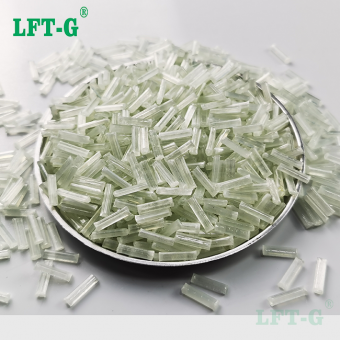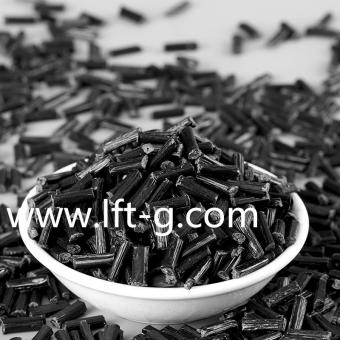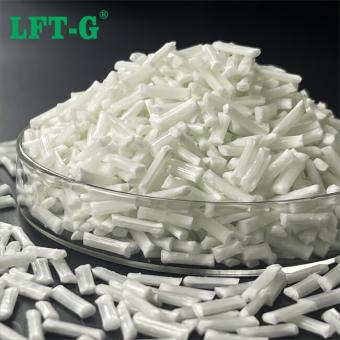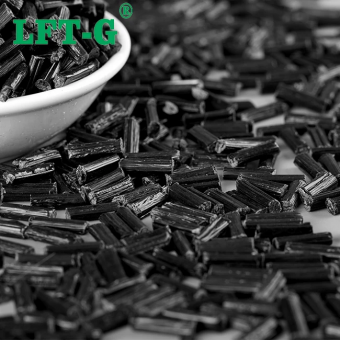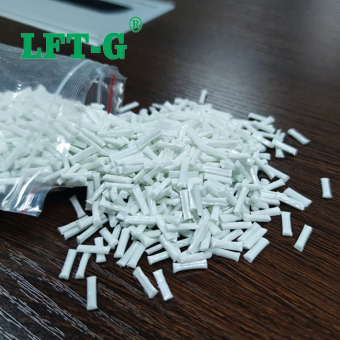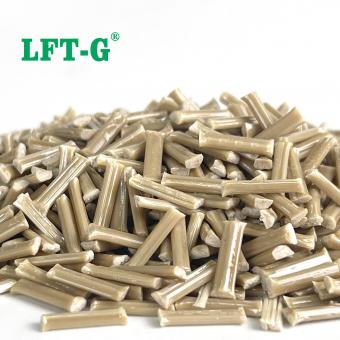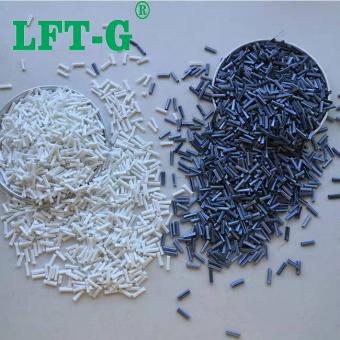-
Xiamen LFT Thermoplastic Polyurethane TPU Long Glass Fiber filling composite industry productProduct number: TPU-NA-LGF Product fiber specificaion: 20%-60% Product features: High toughness, High toughness, Low water absorption, High dimensional stability, chemical resistance, good product appearance.
- Low water absorption price good
- footwear shoes uses
- Columnar particle safty plastic
- Natural color images sa
- Industrial supplies film automotive
- Sample available tpu 3d printing
Tags :
-
Xiamen PLA Polylactic Acid green materials can be recycled long carbon fiber reinforcedPLA (polylactic acid) is a semi-crystalline thermoplastic polyester. It is derived from renewable resources and is therefore classified as a bioplastic. PLA is usually made from plant starch. This origin eventually resulted in the two key monomers used in PLA synthesis - lactic acid and lactide. Each monomer can be used to produce PLA by a number of different processes. Low molecular weight PLA was first produced in 1932. In 1952, DuPont further developed the process and created the high molecular weight PLA. PLA is easy to print. It is biodegradable and therefore more environmentally friendly than ABS. The production of PLA also requires much less energy. Long Carbon Fiber Reinforced Thermoplastic LFT® is A LGF or LCF compound , through Centerfill manufacturing method which Offers exceptional Properties for weight and Cost reduction. With pellet length of 7-25mm and a range of 20%-70% of LGFor LCF content , LFT® Products family consist of Tailor made solutions to the Industry’s vast requirements , such as: · LFT® - Fulfills heat stability requirements. · LFT® - Offer Climate resistant Properties including UV resistance. · LFT® - Ultra Performance & safety , with exceptional impact resistance Features, especially at low temperatures. · LFT® - Cost Effective P.s. Centerfill manufacturing method:Centerfill uses our proprietary technology to introduce glass roving (GFR), which consists of several thousand filaments, into an impregnating device and melt the thermoplastic resin, uniformly impregnating between the filaments and then cutting them into pellets. Manufacture. How Does Composite Differ From Plastics? Plastic components are generally made from a single polymer injection, or sometimes a two-stage process that overmolds rubber onto a part for specific applications such as grip and seal. They are relatively easy to manufacture, generally involving a single-stage operation. Composites, on the other hand, are always two or more co-processed materials, achieving better properties than the individual components can deliver. They are also intrinsically more complex to manufacture. They generally require manual lay-up processes and tend to be much more expensive in labor terms than simple, automatable molding operation outputs. Composites are generally intrinsically stronger than equivalent plastic parts by a large factor. This allows composite parts to deliver higher strength and reduced weight, compared with a similar plastic component. Plastic parts are, in most regards, shape, and size unlimited. Composite parts are rarely used for very small components but can be very large, but they are quite restricted in the complexity of shapes and fine detail. Broadly, plastics are used for low-cost, high-volume applications, whereas composites are considerably more costly and are used for high-value and lower-volume tasks. Xiamen LFT Composite Plastic Co., Ltd. Xiamen LFT composite plastic Co., Ltd. was founded in 2009 by veterans of the thermoplastic-reinforced composite industry and is one of the global suppliers of long fiber reinforced thermoplastic materials, integrating research, production, and marketing of our own brand. Our products have passed the ISO9001&16949 system certification and have been awarded several national trademarks and patents. Our products can be used in the manufacture of home appliances, aerospace, automotive, military, electrical, and other components, as well as medical equipment, sporting goods, daily necessities, and other fields. The company has been adhering to the management belief of quality first, laying a solid foundation at home and abroad, and has been unanimously recognized by customers at home and abroad.
- PLA natural color virgin plastic
- quick and easy prototypes GFRP
- renewable sources
- 3d print plastic good appearance
- long fiber filled modified plastic
- China manufacturer made
Tags :
-
LFT-G Polypropylene PP reinforced long glass fiber high mechanical properites home appliance partsPP filling Long glass fiber PP (polypropylene), as one of the general-purpose plastic materials, has a large production volume and low price, as well as excellent comprehensive performance, good chemical stability, and better molding and processing performance. However, the shortcomings of PP, such as low strength, low service temperature, low hardness, and poor low-temperature impact strength, have seriously limited its application areas. Therefore, engineers by adding glass fiber, calcium carbonate and other reinforcing materials in PP, and when the length of the glass fiber and other lengths exceed the critical size, the mechanical properties are improved by leaps and bounds! Long Glass Fiber Reinforced PP (LFT-PP) is a very typical thermoplastic composite material, which is generally a column of particles with a length of 12 mm to 25 mm and a diameter of about 3 mm. In these particles, the glass fibers have the same length as the particles, the content of glass fibers can vary from 20% to 70%, and the color of the particles can be matched according to customer requirements. PP-LGF advantages 1. longer fiber length, significantly improve the mechanical properties of the products. 2. high strength, good impact resistance, especially suitable for furniture, automotive parts. 3. high creep resistance, good dimensional stability, high precision parts molding. 4. excellent fatigue resistance. 5. better stability in high temperature and humid environment. 6. molding process fiber can be in the molding mold relative movement, fiber damage is small. LGF VS SGF Application Automotive industry: front-end module, door module, gearshift mechanism, electronic gas pedal, instrument panel frame, cooling fan and frame, battery tray, bumper bracket, underbody protection plate, sunroof frame, etc., used to replace reinforced PA or metal materials. Home appliance industry: washing machine drum, washing machine triangle bracket, air conditioner fan, etc., used to replace short glass fiber reinforced PA, ABS or metal materials. Communication, electronics, electrical industry: communication electronics industry, high-precision connectors, ignition components, coil shafts, relay base, microwave oven transformer coil frame / frame, electrical connectors, solenoid valve package, scanner components, etc.. Others: power tool shells, water pump or water meter shells, impellers, bicycle skeletons, skis, ground locomotive pedals, military/civilian safety helmets, safety shoes, such as the head of the package, used to replace the short fiberglass-reinforced PA, PPO and so on. Produce processing Certification About us Xiamen LFT Composite Plastic Co.,LTD was established in 2009, is a brand-name global suppliers of long fiber reinforced thermoplastic materials integrating product research & development(R&D), production and sale marketing. Our LFT products have passed the ISO9001&16949 system certification and have obtained lots of national trademarks and patents, covering the fields of automotive, military parts and firearms, aerospace, new energy, medical equipment, power wind energy, sports equipment, etc.
- LFT-G homopoymer plastic PP
- PP injection molded lgf natural color
- Polypropylene composite plastic modified
- pp gf30 for electrical connector price
- PP pellets lgf 30 polymer
- PP car parts use factory made
Tags :
-
Xiamen LFT Flame Resistance Polyphenylene Sulfide Long Carbon Fiber Reinforced CompoundsPolyphenylenesulfide, is a thermoplastic special engineering plastic with excellent comprehensive properties.
- pps fiber special thermoplastic resin
- Engineering plastics high mechanical properties
- new materials instead metal steel
- Injection molding made in China plastic
- demanding industrial applications
- carbon fiber natural color enhanced
Tags :
-
Xiamen LFT-G reinforced PBT plastic Long glass fiber polymers high qualityProduct grade: General grade Fiber specification: 20%-60% Product feature: High toughness, Low warpage Product application: Electronic appliances, Machinery parts etc.
- PBT resin high mechanical properties
- Electronic appliances composites
- sample available pbt
- Natural color widely applications
- Fiber filling material compounds
- High toughness industry use
Tags :
-
Xiamen LFT Thermoplastic Polyurethane TPU Long Glass Fiber filling composite industry productProduct number: TPU-NA-LGF Product fiber specificaion: 20%-60% Product features: High toughness, High toughness, Low water absorption, High dimensional stability, chemical resistance, good product appearance.view more
-
LFT PPS long glass fiber reinforcement thermoplastic composite granulesPPS long glass fiber reinforced thermoplastic granules for introduction and properties
- glass fiber pps thermoplastic material
- pps fiber injection molding Polyphenylene sulfide
- pps lgf glass fiber car parts frame
- natural color pps lgf composite
- PPS polymer glass fiber pellets
- thermoplastic virgin granules PPS
Tags :
-
Xiamen LFT-G reinforced PBT plastic Long glass fiber polymers high qualityProduct grade: General grade Fiber specification: 20%-60% Product feature: High toughness, Low warpage Product application: Electronic appliances, Machinery parts etc.view more
-
Xiamen LFT Thermoplastic Polyurethane TPU Long Glass Fiber filling composite industry productProduct number: TPU-NA-LGF Product fiber specificaion: 20%-60% Product features: High toughness, High toughness, Low water absorption, High dimensional stability, chemical resistance, good product appearance.view more
-
Xiamen LFT Thermoplastic Polyurethane TPU Long Glass Fiber filling composite industry productProduct number: TPU-NA-LGF Product fiber specificaion: 20%-60% Product features: High toughness, High toughness, Low water absorption, High dimensional stability, chemical resistance, good product appearance.view more
-
Xiamen LFT-G reinforced PBT plastic Long glass fiber polymers high qualityProduct grade: General grade Fiber specification: 20%-60% Product feature: High toughness, Low warpage Product application: Electronic appliances, Machinery parts etc.view more
-
Xiamen LFT-G reinforced PBT plastic Long glass fiber polymers high qualityProduct grade: General grade Fiber specification: 20%-60% Product feature: High toughness, Low warpage Product application: Electronic appliances, Machinery parts etc.view more

 e-mail
e-mail English
English français
français Deutsch
Deutsch русский
русский italiano
italiano español
español português
português العربية
العربية 日本語
日本語 한국의
한국의 中文
中文












